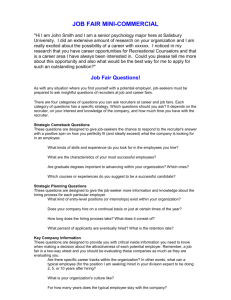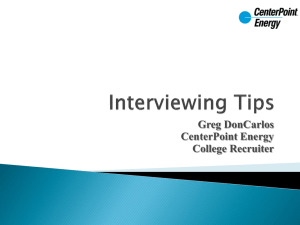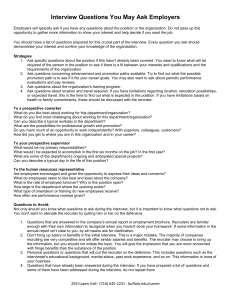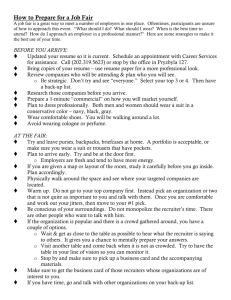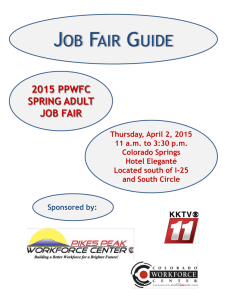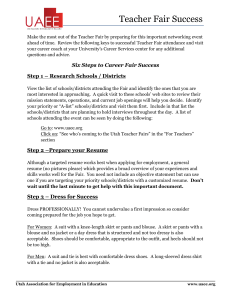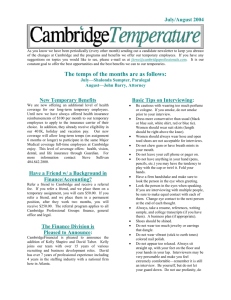How to Work a Career Expo Script
advertisement
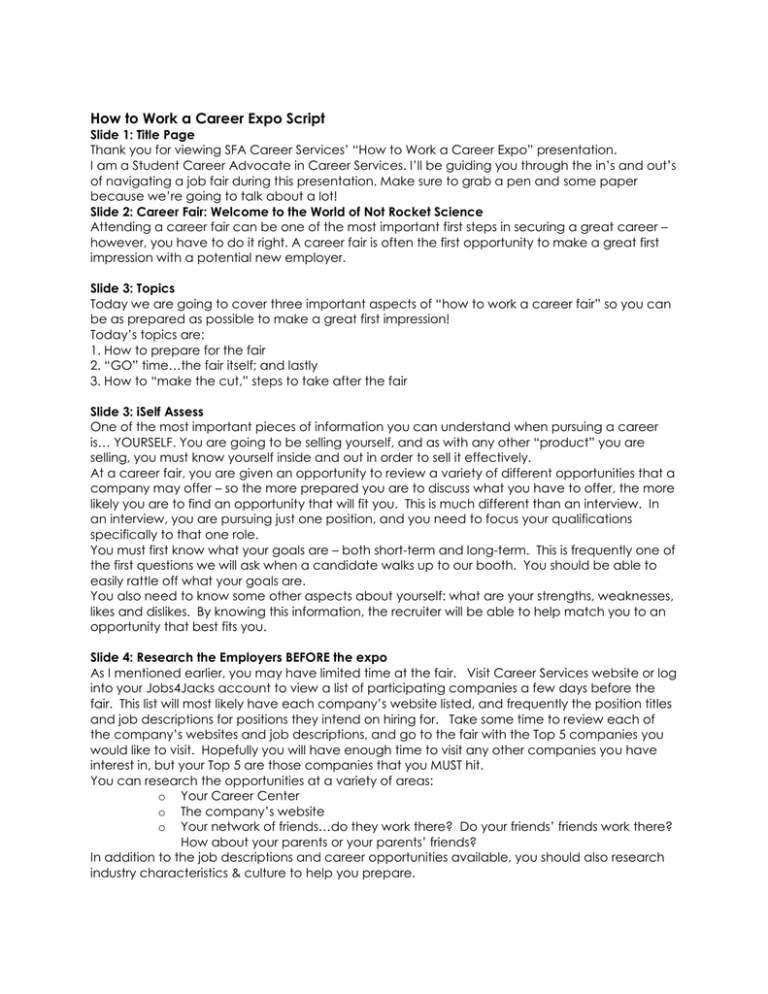
How to Work a Career Expo Script Slide 1: Title Page Thank you for viewing SFA Career Services’ “How to Work a Career Expo” presentation. I am a Student Career Advocate in Career Services. I’ll be guiding you through the in’s and out’s of navigating a job fair during this presentation. Make sure to grab a pen and some paper because we’re going to talk about a lot! Slide 2: Career Fair: Welcome to the World of Not Rocket Science Attending a career fair can be one of the most important first steps in securing a great career – however, you have to do it right. A career fair is often the first opportunity to make a great first impression with a potential new employer. Slide 3: Topics Today we are going to cover three important aspects of “how to work a career fair” so you can be as prepared as possible to make a great first impression! Today’s topics are: 1. How to prepare for the fair 2. “GO” time…the fair itself; and lastly 3. How to “make the cut,” steps to take after the fair Slide 3: iSelf Assess One of the most important pieces of information you can understand when pursuing a career is… YOURSELF. You are going to be selling yourself, and as with any other “product” you are selling, you must know yourself inside and out in order to sell it effectively. At a career fair, you are given an opportunity to review a variety of different opportunities that a company may offer – so the more prepared you are to discuss what you have to offer, the more likely you are to find an opportunity that will fit you. This is much different than an interview. In an interview, you are pursuing just one position, and you need to focus your qualifications specifically to that one role. You must first know what your goals are – both short-term and long-term. This is frequently one of the first questions we will ask when a candidate walks up to our booth. You should be able to easily rattle off what your goals are. You also need to know some other aspects about yourself: what are your strengths, weaknesses, likes and dislikes. By knowing this information, the recruiter will be able to help match you to an opportunity that best fits you. Slide 4: Research the Employers BEFORE the expo As I mentioned earlier, you may have limited time at the fair. Visit Career Services website or log into your Jobs4Jacks account to view a list of participating companies a few days before the fair. This list will most likely have each company’s website listed, and frequently the position titles and job descriptions for positions they intend on hiring for. Take some time to review each of the company’s websites and job descriptions, and go to the fair with the Top 5 companies you would like to visit. Hopefully you will have enough time to visit any other companies you have interest in, but your Top 5 are those companies that you MUST hit. You can research the opportunities at a variety of areas: o Your Career Center o The company’s website o Your network of friends…do they work there? Do your friends’ friends work there? How about your parents or your parents’ friends? In addition to the job descriptions and career opportunities available, you should also research industry characteristics & culture to help you prepare. Slide 5: What do I bring? There are several pieces 0f information that you can bring with you to the fair. First and foremost, and a career fair MUST, is a professional, well-written, mistake-free resume. Make sure to have someone proof read your resume prior to the fair to ensure that it’s error-free. You will also want to bring multiple copies. Even though you have chosen your Top 5 you will hopefully have time to visit many more than that, and you will want to be prepared. Along with your resume should be a list of pre-contacted references (preferably professional references). Since you will be targeting your Top 5 companies, you will also have an opportunity to tailor a cover letter to those companies. However, be forewarned, that you will want to MAKE SURE to give the right cover letter to the right company! There have been instances in the past when I have received a cover letter not addressed to me or my company. Although it can be a funny situation, it’s not the correct impression that you want to leave. Becoming more common are candidates bringing business cards in place of resumes. I’m not sure that I’m sold on this concept yet, but it’s an option that I thought I’d tell you about For those of you pursuing a career in advertising, Public Relations, graphic design, etc., bringing your portfolio with you would not be a bad idea. The companies may prefer to wait until an interview to review it; but it doesn’t hurt to have one with you. “Cheat” sheets can be helpful with your Top 5 companies…right before you approach the booth, review your cheat sheet to remind yourself of some top points you wanted to mention to show that you’ve done your research. Slide 6: Elevator speech One of the most daunting aspects of attending a career fair is the most important… walking up and introducing yourself to a recruiter. One of the easiest and most widely used techniques today is to put together an “elevator speech.” The premise behind an elevator speech is this challenge: How would you concisely and accurately “sell” yourself to a potential employer if fate placed you both on an elevator, and you only had the time it takes to get from the top floor to the bottom floor? Developing a great elevator speech is the key to a great first impression and solid conversation with a recruiter. To begin, you will want to introduce yourself by stating your name, major and graduation date. Next, state your reason for attending the fair. Are you there to network, as you are not graduating for another three semesters? Or are you there seeking immediate full-time employment? To follow-up, you’ll want to mention a point or two about the organization, just to prove that you have done your research. Lastly, and probably the most important part of the elevator speech, is to communicate how your skills, education and experience relate to available career opportunities, or to what you are seeking in a position. I know that that sounds like a lot of information to include in just 15-30 seconds, but it’s definitely attainable! Here, let me give you an example of an elevator speech to help if you’re looking to create your own: “Hi! My name is Mary Smith and I am a senior Marketing major, seeking a full-time marketing position upon my graduation this December. I recently completed an internship with XYZ & Associates, a prominent marketing research company in New York City. My internship was a vital learning experience and afforded me the opportunity to be introduced to the ever-changing marketing industry, as well as develop extensive skills in conducting market research and analysis. One thing that particularly caught my attention about Sample Company is being rated a “Top 50 Employers to Work For” for five consecutive years! I fully appreciate your organization’s stance on participating in philanthropic work and professional development of the individual. This, among many other reasons, is why I am interested in pursuing a career with Sample Company.” See, that wasn’t so bad, was it? You will want to be careful that your speech doesn’t sound too scripted – so be sure to practice several times prior to the fair. Slide 7: Create a Game Plan You’ve already decided on your Top 5…once you arrive to the fair, they will give you a map of where the companies are. Map it out so you can make the most of your time. If you find that one of your Top 5 is busy, go to your next stop and come back. The lines will die down at some point, and you want to make sure you hit up everyone you planned. Ideally you will have enough time to hit up more than your Top 5, so you don’t want to spend the whole fair waiting in line. You will also want to know what your next week or two’s schedule looks like. 90% of the time you will just be learning about an organization and they’ll give you directions on how to follow up or proceed. However, you just may make quite an impression on the recruiter, and they may want to schedule an interview with you at that point! So if you know your schedule, you can make the appointment at that time, and feel confident that you can stick to it. Slide 8: Dress to Impress A neat and organized appearance can go a long way in making a good impression. Making sure your clothes are clean and pressed is half the battle. Spots on ties, runs in hose, or wrinkled clothes can do more damage than you think. When it comes to your hair basically DON’T try to make a statement with it and you should do OK. Neat and clean and conservatively styled are all you need to remember. When you check-in at the fair, you will most likely be given an adhesive badge to use as a nametag. A nametag goes on your RIGHT CHEST. Why? Because as you shake hands, you want your nametag to nametag to angle towards them. No matter what the “dress code” states for the fair, dressing conservatively and professionally is always the best bet. Wear a suit, even if it may not be necessary. It makes a professional statement even if the recruiters attending are dressed business casual or casually. Yes, a suit can be expensive, but consider it to be a very wise investment. You’ll also need it when you start to interview, so you might as well purchase it now! Be careful of the “trends” that can influence your appearance – even if you’re going clubbing after the event, you won’t want to wear your “clubbing” clothes to the fair! What’s the earring/piercing rule? Basically, if you’re a guy--no earrings are appropriate, for a woman-- stick to your basic earrings (one in each ear). Piercing anywhere else is pretty much considered inappropriate. In any case, it’s better to be safe than sorry! Dress for Success – Think “Conservative” Wear a suit Be careful of trends Earrings/piercings Neat and organized: Nametag on right Clothing that is clean and pressed Neat, professional hairstyle Slide 9: What Not to Wear Shorts Uncomfortable shoes Workout clothes Short dresses/skirts Slide 10: What to expect Career fairs are typically loud, busy and hectic, especially during peak times. The fair usually starts to die down within the last ½ to 1 hour. Some people may be tempted to attend during that time so they don’t have to deal with the rush; however, I wouldn’t recommend it as some recruiters will close up shop early, and you may miss out on the opportunity to visit one of your Top 5’s. It is also very likely that your Top 5 are the same as other attendee’s Top 5 – so be prepared for lines. If you are in a line, and you still have other organizations to see, feel free to step away for a bit to see the others, and then come back. Also, if you notice that the recruiter is giving the same “schpeel” to all the candidates, feel free to step in and listen. You can still give your elevator speech after the other candidates walk away, but I’m sure the recruiter would appreciate you saving their voice! In today’s economy, many of the companies that have traditionally been top hirers may have reduced, or even eliminated, hiring. However, you will still most likely see them at the fair. Even though a company may not be hiring, they may still want to keep their name out there. Don’t get discouraged by this. After your elevator speech, simply ask if they are currently hiring – and they’ll tell you. Take this as an opportunity to learn, but then focus most of your efforts on those that are currently hiring. You may also come across companies that don’t accept resumes at the fair. Don’t take this personally – it’s most likely a company policy. If they don’t take your resume, just ask them how they would like you to proceed. You may be directed to email it to them, they may direct you to a company website to complete an online application, or they may not tell you to do anything depending on their staffing needs. Just ask! Many times a recruiter will tell you what step(s) you should take from here…be sure to listen! If they tell you to apply online, or to send a resume, or to sign up for interviews – DO IT! You’ll be listening to many different people that day and it’s likely that you’ll forget what you should be doing next…so feel free to take notes after you leave their booth if necessary. Slide 11: Did you know? At our fairs, we provide bag, purse and coat check; you don’t want to carry any unnecessary items into the career event. Slide 12: Dos and Don’ts To summarize, here is a list of some career fair do’s: Use your elevator speech Develop & use a firm handshake Check for fresh breath Smile, use eye contact and show personality Ask open-ended questions Collect company literature & business cards Remain professional Listen carefully to recruiter Offer resume Thank recruiters for their time Follow up! Check out our list of career fair points Slide 13: Take Me Home Tonight Here are some things to not leave the fair without: Business cards from the recruiters you met Notes about contacts you made Information about organizations you have contacted A better sense of your career options Self-confidence in interacting with employer representatives Slide 14: Say Thank You Recruiters see MANY candidates at the career fair, and even though you made a GREAT impression on the recruiter, you ALWAYS want to follow up. After you spoke with the Recruiter, you should have collected his/her business card. If you spoke with someone other than the recruiter, ask for the both their card, and the recruiter’s card, and follow up with both. The best thing you’ll want to do in this situation is make your follow up personal. If there was something that you talked about with the recruiter that would make you stand out and help them to remember you, put that in your follow up. As far as how to follow up, that’s up to you. An email is immediate whereas a letter or note shows a little more effort. Both have their advantages so do whichever you feel is more appropriate. The most important thing is that you DO IT! Another method of follow up is via the phone. This is not standard today, but it’s an option – just be careful to not move to STALKER status! As I mentioned earlier, if a Recruiter asked you to email a resume to them, to complete an online application, or to sign up for an interview on campus…DO IT! A positive first impression can quickly be ruined if you don’t follow up appropriately. Slide 15: Making the Cut Depending on your graduation date, and also if the company is hiring or not, you may not be able to pursue a company immediately. If that is the case, file that information away. I recommend having a “Career Opportunities” folder or notebook where you keep notes, business cards and company literature. Write down who you met with so when you follow up down the road, you will remember the important details and who you can follow up with. You will also want to be accessible…when a Recruiter contacts you for a follow up conversation or potentially an interview, you want to be flexible. Remember, you were one of many at the fair, so if you’re not available when they need you to be, they may move on to the next person. Questions? Contact Career Services at 936-468-3305 by phone or via email at careerservices@sfasu.edu. We are located on the third floor of the Rusk Building or visit us online at www.sfasu.edu/careerservices. See you at the fair!
